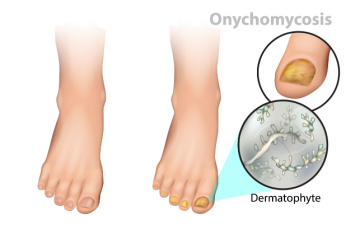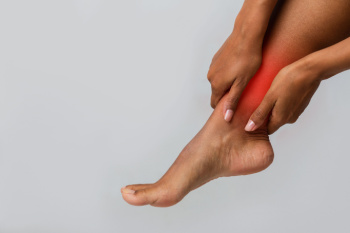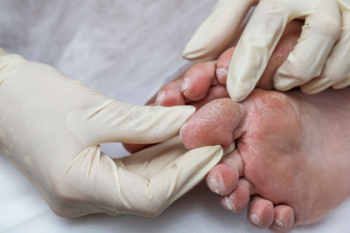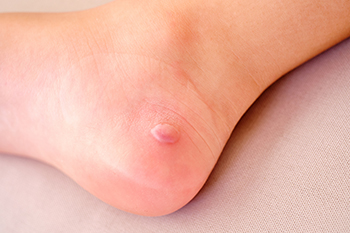Items filtered by date: March 2025
Managing Fungal Toenail Infections

Toenail fungus causes toenails to become brittle, crumbly, discolored, or misshapen. In some cases, the nails may thicken, separate from the nail bed, or emit a foul odor. The fungus thrives in warm, moist environments, making it easy to contract in places like locker rooms or public shower areas. Symptoms include pain or discomfort when wearing shoes or walking. The condition can also spread to other nails or skin, if left untreated. Treating toenail fungus can be challenging, as visible results often take months due to the slow growth of toenails. Available treatments include topical medications, oral antifungal drugs, and laser therapy. Podiatrists often recommend a combination of oral and topical treatments for the best results. However, oral medication may come with side effects, and topical treatment may not be as effective for severe cases. If you have toenail fungus, it is suggested that you schedule an appointment with a podiatrist.
If left untreated, toenail fungus may spread to other toenails, skin, or even fingernails. If you suspect you have toenail fungus it is important to seek treatment right away. For more information about treatment, contact Shalonda Davidson, DPM of Instride Carolina Foot Care. Our doctor can provide the care you need to keep you pain-free and on your feet.
Symptoms
- Warped or oddly shaped nails
- Yellowish nails
- Loose/separated nail
- Buildup of bits and pieces of nail fragments under the nail
- Brittle, broken, thickened nail
Treatment
If self-care strategies and over-the-counter medications does not help your fungus, your podiatrist may give you a prescription drug instead. Even if you find relief from your toenail fungus symptoms, you may experience a repeat infection in the future.
Prevention
In order to prevent getting toenail fungus in the future, you should always make sure to wash your feet with soap and water. After washing, it is important to dry your feet thoroughly especially in between the toes. When trimming your toenails, be sure to trim straight across instead of in a rounded shape. It is crucial not to cover up discolored nails with nail polish because that will prevent your nail from being able to “breathe”.
In some cases, surgical procedure may be needed to remove the toenail fungus. Consult with your podiatrist about the best treatment options for your case of toenail fungus.
If you have any questions, please feel free to contact our office located in Statesville, NC . We offer the newest diagnostic and treatment technologies for all your foot care needs.
Ankle Fracture? Don’t Wait for Treatment
Common and Uncommon Causes of Ankle Pain

Ankle pain can stem from various conditions, ranging from everyday injuries to underlying medical issues. Common causes include sprains, strains, fractures, and arthritis, which can lead to swelling, stiffness, and discomfort. Overuse injuries, such as tendonitis, are also frequent, especially in athletes and active individuals. Less common causes of ankle pain include nerve compression, gout, infections, or vascular issues, which may result in persistent or worsening symptoms. Structural problems, like flat feet or high arches, can also contribute to chronic discomfort. Ignoring ankle pain may lead to long-term mobility issues. If you are experiencing ongoing pain, swelling, or instability of your ankles, it is suggested that you consult a podiatrist for a proper diagnosis and appropriate care.
Ankle pain can be caused by a number of problems and may be potentially serious. If you have ankle pain, consult with Shalonda Davidson, DPM from Instride Carolina Foot Care. Our doctor will assess your condition and provide you with quality foot and ankle treatment.
Ankle pain is any condition that causes pain in the ankle. Due to the fact that the ankle consists of tendons, muscles, bones, and ligaments, ankle pain can come from a number of different conditions.
Causes
The most common causes of ankle pain include:
- Types of arthritis (rheumatoid, osteoarthritis, and gout)
- Ankle sprains
- Broken ankles
- Achilles tendonitis
- Achilles tendon rupture
- Stress fractures
- Bursitis
- Tarsal tunnel syndrome
- Plantar fasciitis
Symptoms
Symptoms of ankle injury vary based upon the condition. Pain may include general pain and discomfort, swelling, aching, redness, bruising, burning or stabbing sensations, and/or loss of sensation.
Diagnosis
Due to the wide variety of potential causes of ankle pain, podiatrists will utilize a number of different methods to properly diagnose ankle pain. This can include asking for personal and family medical histories and of any recent injuries. Further diagnosis may include sensation tests, a physical examination, and potentially x-rays or other imaging tests.
Treatment
Just as the range of causes varies widely, so do treatments. Some more common treatments are rest, ice packs, keeping pressure off the foot, orthotics and braces, medication for inflammation and pain, and surgery.
If you have any questions, please feel free to contact our office located in Statesville, NC . We offer the newest diagnostic and treatment technologies for all your foot care needs.
Preventing Limb Loss in Diabetic Patients

Diabetic limb salvage focuses on preserving affected extremities by addressing diabetic wounds early and effectively. Diabetes significantly impacts foot health, often causing foot ulcers and infections due to poor blood circulation, nerve damage known as peripheral neuropathy, and peripheral vascular disease, a condition where arteries narrow or become blocked. About 15 percent of diabetic patients experience foot ulcers, which, if left untreated, can lead to severe infections of the skin or underlying bones, increasing the risk of limb loss. A podiatrist plays an essential role in diabetic limb salvage by diagnosing foot conditions, managing wound care, and performing procedures like debridement to remove infected tissue. Podiatrists also use angioplasty or stenting to improve circulation, offloading techniques to reduce pressure on wounds, and orthopedic shoe inserts to support and protect the feet. Early podiatric care significantly reduces the risk of surgery or loss of limb. If you are suffering from diabetic foot problems, it is suggested that you schedule an appointment with a podiatrist for an exam, diagnosis, and ongoing treatment.
Limb salvage can be an effective way in preventing the need for limb amputation. If you have diabetes, cancer, or any other condition that could lead to foot amputation if left unchecked, consult with Shalonda Davidson, DPM from Instride Carolina Foot Care. Our doctor will assess your condition and provide you with quality foot and ankle treatment.
What Is Limb Salvage?
Limb salvage is the attempt of saving a limb, such as the foot from amputation. Podiatrists also try to make sure that there is enough function in the foot after the salvage that it is still usable. Diabetes is the number one cause of non-traumatic amputations in the United States. Those with diabetes experience poor blood circulation, which prevents proper healing of an ulcer. If the ulcer is left uncheck, it could become infected, which could result in the need for amputation.
However, there are other causes as well, such as cancer and traumatic injury. Links between higher mortality rates and amputation have been found. This translates into higher healthcare costs, and a reduced quality of life and mobility for amputees. Podiatrists have attempted to increase the prevalence of limb salvage in an attempt to solve these issues.
Diagnosis and Treatment
Limb salvage teams have grown in recent years that utilize a number of different treatments to save the infected limb. This includes podiatrists that specialize in wound care, rehabilitation, orthotics, and surgery. Through a combination of these methods, limb salvage has been found to be an effective treatment for infected limbs, and as an alternative to amputation. Podiatrists will first evaluate the potential for limb salvage and determine if the limb can be saved or must be amputated.
If you have any questions, please feel free to contact our office located in Statesville, NC . We offer the newest diagnostic and treatment technologies for all your foot care needs.
What Are Diabetic Blisters?

Diabetic blisters are a common yet often overlooked complication of diabetes. These blisters typically appear on the feet and legs and are filled with clear fluid. They can be painless at first but may become sore or irritated if left untreated. Diabetic blisters are more likely to form due to poor circulation and nerve damage caused by high blood sugar levels, which makes the skin more fragile and susceptible to injury. While these blisters often heal on their own, they can become infected if not properly cared for. A podiatrist can help by properly cleaning and dressing the blister to reduce the risk of infection. This type of doctor may also advise on keeping the area protected and suggest ways to prevent further blisters. Additionally, a podiatrist may recommend custom footwear, or orthotics to reduce friction and pressure on the feet. If you have diabetes and have developed blisters, it is suggested that you are under the care of a podiatrist who can help you to manage this serious condition.
Blisters may appear as a single bubble or in a cluster. They can cause a lot of pain and may be filled with pus, blood, or watery serum. If your feet are hurting, contact Shalonda Davidson, DPM of Instride Carolina Foot Care. Our doctor can provide the care you need to keep you pain-free and on your feet.
Foot Blisters
Foot blisters are often the result of friction. This happens due to the constant rubbing from shoes, which can lead to pain.
What Are Foot Blisters?
A foot blister is a small fluid-filled pocket that forms on the upper-most layer of the skin. Blisters are filled with clear fluid and can lead to blood drainage or pus if the area becomes infected.
Symptoms
(Blister symptoms may vary depending on what is causing them)
- Bubble of skin filled with fluid
- Redness
- Moderate to severe pain
- Itching
Prevention & Treatment
In order to prevent blisters, you should be sure to wear comfortable shoes with socks that cushion your feet and absorb sweat. Breaking a blister open may increase your chances of developing an infection. However, if your blister breaks, you should wash the area with soap and water immediately and then apply a bandage to the affected area. If your blisters cause severe pain it is important that you call your podiatrist right away.
If you have any questions, please feel free to contact our office located in Statesville, NC . We offer the newest diagnostic and treatment technologies for all your foot care needs.

